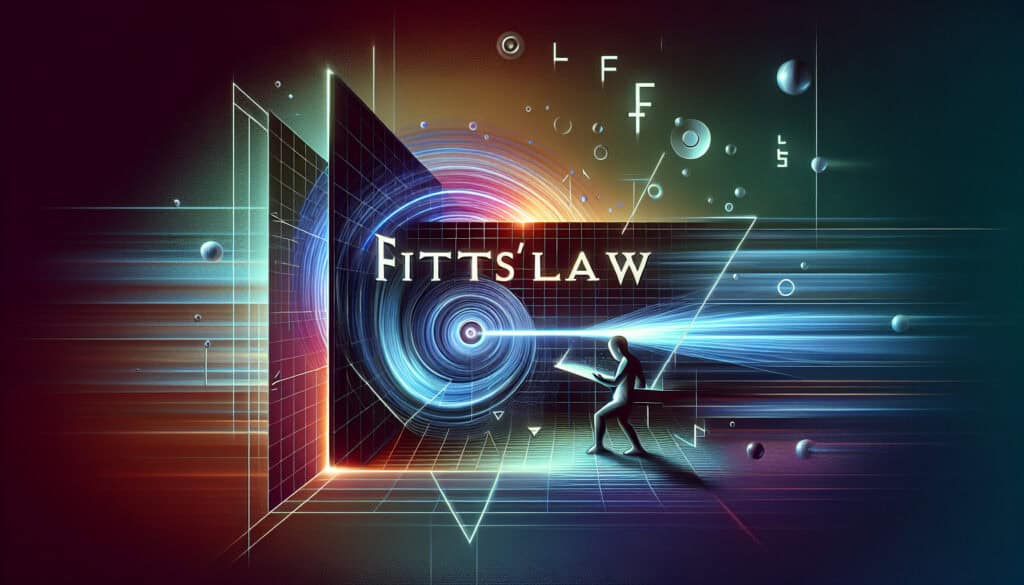To predict the time it takes to move to a target area.
- Méthodologies : Ergonomie
Fitts’ Law

Fitts’ Law
- Principes de conception, Ergonomie, Facteurs humains, Interaction homme-machine, Conception d'interaction, Utilisabilité, Expérience utilisateur (UX), Interface utilisateur (UI)
Objectif :
Comment il est utilisé :
- A model of human movement that predicts the time required to rapidly move to a target area is a function of the ratio between the distance to the target and the width of thetarget. It is widely used in interface utilisateur (UI) design to optimize the placement and size of interactive elements.
Avantages
- Provides a scientific basis for Conception de l'interface utilisateur decisions; Helps to improve the usability of interfaces.
Inconvénients
- Does not account for all factors that affect user interaction; Can be difficult to apply in complex interfaces.
Catégories :
- Ergonomie, Conception de Produits
Idéal pour :
- Designing user interfaces with large, easy-to-click buttons and other interactive elements.
Fitts’ Law plays a significant role in various industries beyond just user conception d'interface, including gaming, mobile app development, and automotive dashboard design, where quick and precise interaction is crucial. In these contexts, engineers and designers employ the principles of Fitts’ Law during the prototyping and testing phases of a project. By assessing how users interact with different target sizes and distances, design teams can accurately determine the optimal dimensions for buttons, sliders, and navigational controls that enhance user experience. For instance, in gaming, positioning action buttons within easy reach of the thumb can lead to a more fluid gameplay experience, while in automotive design, ensuring that dashboard controls are easily accessible without distracting the driver is vital for safety. Typically, usability researchers or product designers initiate studies based on Fitts’ Law during user testing sessions, allowing them to gather quantitative data on movement times. This data enables design teams to understand user behavior better and refine their products to meet specific ergonomic criteria, leading to interfaces that not only perform well but also resonate with users’ physical capabilities and expectations, thereby facilitating greater adoption and satisfaction.
Principales étapes de cette méthodologie
- Identify target interactive elements on the interface.
- Determine the distance from the user's start position to the target.
- Measure the width of the target area (interactive element).
- Calculate the Index of Difficulty (ID) using the formula ID = log2(2D/W), where D is distance and W is width.
- Estimate the movement time using Fitts' Law formula: MT = a + b * ID, where MT is movement time, and a and b are empirical constants.
- Adjust the size and placement of the interactive elements based on the calculated movement time and index of difficulty.
- Iterate the design by testing different configurations to optimize user performance.
Conseils de pro
- Conduct user testing to refine the size and placement of interactive elements, following iterative design principles grounded in Fitts' Law.
- Analyze the spatial layout of UI components; grouping frequently used items can reduce the distance to targets, enhancing efficiency.
- Implement hover states and touch feedback that provide users with a sense of target engagement, ensuring more precise interactions as suggested by Fitts' Law.
Lire et comparer plusieurs méthodologies, nous recommandons le
> Référentiel méthodologique étendu <
ainsi que plus de 400 autres méthodologies.
Vos commentaires sur cette méthodologie ou des informations supplémentaires sont les bienvenus sur le site web de la Commission européenne. section des commentaires ci-dessous ↓ , ainsi que toute idée ou lien en rapport avec l'ingénierie.
Contexte historique
1986
(si la date est inconnue ou n'est pas pertinente, par exemple "mécanique des fluides", une estimation arrondie de son émergence notable est fournie)

Articles Similaires
Questionnaires sur les troubles musculo-squelettiques
Tests à plusieurs variables (MVT)
Analyse de régression multiple
Systèmes de capture de mouvement
Méthode MoSCoW
Test de la médiane de Mood